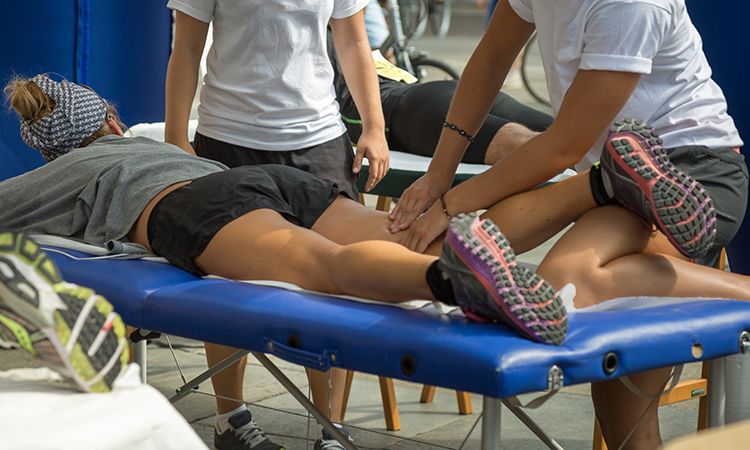
Start your career in Sports Massage
Our courses set the benchmark for industry training and ongoing support. If you're ready to get started, so are we.
In this handy step-by-step guide, we have covered the techniques used to do sports massage on legs alongside when you should use them.
Understanding how to do sports massage on legs is a key area that any individual who participates in sport would love to know. In this handy step-by-step guide, we have covered the techniques used to do sports massage on legs alongside when you should use them. Although this guide will provide you with the basic knowledge of massage techniques, it’s unlikely you will receive the same experience as you would from a fully qualified sports massage coach. These types of sports massage techniques can be applied to the lower leg and thigh area, for ankle massage or knee injury massage the method would vary.
The effleurage technique is a good warm-up technique for a sports massage on legs, it consists of light friction used as a massage treatment. Effleurage is a good technique to work into the start of a sports massage on legs, this is made up of long, stroking movements performed using your flat hands or fingers.
This massage technique helps warm the legs up by increasing the flow within the lymphatic system and assisting general circulation around the body.
Kneading is the next vital stage in sports massage which aims to roll out the tension in the legs, this involved manipulating leg muscle tissues in several ways. Throughout the kneading process, it will involve squeezing, lifting and moving tissues, the pressure will alternate throughout this stage. The change in pressure and hand strokes in the kneading process will encourage pumping responses from the veins, this will speed up the blood flow through the vessels and release tension within the legs.
Wringing is a massage technique used for sports such as tennis on leg muscles as tissue manipulation whereby tissues are lifted away from the bone. During this process when massaging the legs the tissue should be pushed from side to side whilst your hands move up and down. Part of wringing massage techniques also includes a squeezing and releasing action of the hands which helps increase circulation in that particular tissue area.
Incorporating wringing into your leg sports massage routine will help remove waste and bring oxygen and nutrients into the focused area, this will help improve leg tissue condition. The main aim of using wringing to massage the legs is to stretch and work muscle fibers to help release tensions and mobilise large muscles.
Hacking can be one of the most effective sports massage techniques to use on your legs, this is carried out by using the border of your hand to strike the muscle tissue within your legs. This strike isn’t necessarily done in a forceful way, it should be done in a light spring-like way to try and soften the areas with any hard tissue. Hacking can be one of the most effective ways to increase blood circulation in the legs, this sports massage technique stimulates the relaxation contraction of any muscle fibers helping overall circulation.
Trigger pointing is key for muscle healing purposes when having a sports massage on your legs, this aims to deactivate any trigger points in your leg muscles. A trigger point is a key to relieving any pain or muscle tightness whilst aiding the original function of the muscles. When looking for a trigger point, it will be a small area that is irritated within a particular muscle or tissue, these tend to be painful. Once you have found the trigger point within your legs, you should apply hard pressure to the area although this may be painful, it will help reduce the pain and release fresh blood.
This sports massage technique will help mobilise tissues, increase blood circulation and help stimulate the removal of waste products around the legs.
Overall understanding how to do sports massage on legs can be difficult which is why people are highly qualified to carry out this type of treatment. There are methods above which you can incorporate into your own massage routine, however, it may not be as effective as a sports massage you may pay for.

Our courses set the benchmark for industry training and ongoing support. If you're ready to get started, so are we.